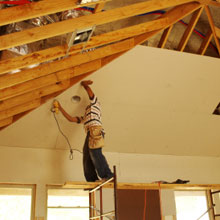By Jim Vallette, Senior Researcher
Healthy Building Network
April 28, 2010
Some building materials are so bland that they draw little notice. Until recently, about the only people who cared about drywall were those who handled it. Beneath paint and other finishes, the boards lay unseen and unconsidered by those living and working in its gypsum cocoon.
Then thousands of complaints erupted, mainly in the Gulf Coast region devastated by the hurricanes of 2004 and 2005. From Florida to Louisiana, people have moved out of their homes. They say that newly installed wallboard is corroding their air conditioning coils, metal pipes and fixtures, and wiring. They blame an egg-like sulfurous odor emanating from the boards for an array of health symptoms, from respiratory distress to heart disease.
Most of the complaints came from homes in which builders installed drywall made in China. These wallboards flooded into the U.S. after the hurricanes and during the housing boom, when demand outstripped domestic production. Most of these boards - over 78 percent in 2006 - were imported from three factories in China run by the German building material giant, Knauf.
Investigations have focused mainly on the symptoms, rather than the causes, of problematic wallboard. Many types of gypsum and additives introduce toxicants into the slurry that becomes wallboard. Understanding and rectifying these root causes is essential for healthy building material evaluation and selection.
Many reports have tied the toxic wallboard in China to natural, mined gypsum that contains higher levels of sulfur than typical of gypsum mined in North America. But other information is pointing toward problems with drywall that implicate far more than a couple of mines in China.
Louisiana Attorney General Buddy Caldwell recently filed a
federal suit against Knauf. He noted the use of coal-fired power plant waste - fly ash and flue gas desulfurization (FGD) waste - by Knauf and other manufacturers in China. These manufacturing processes resulted in "defective, noxious, and toxic drywall which emits a variety of dangerous chemicals," including formaldehyde, hydrogen sulfide and carbonyl sulfide. The AG's complaint also notes the presence of
additives that may contribute to the problem. The use of these additives, and FGD waste, is a common denominator between some of the drywall from China and a lot of the drywall now produced in North America.
Ten of the 44 complaints detailed by the
Consumer Product Safety Commission last fall involved drywall made in the United States.
CBS News compared U.S.- and Chinese-made drywall by sending samples to University of Florida professor, Tim Townsend. The professor concluded, "The results tell me that we shouldn't just be focused solely on defective Chinese drywall. We need to be backing up and looking at the product of drywall itself."
Federal courts are considering two cases filed by homeowners against National Gypsum and one against Georgia Pacific. In
Swidler v. Georgia Pacific, homeowners in Florida say that GP manufactured problematic wallboard in North America using FGD waste. The plaintiffs claim, "[I]t is the synthetic gypsum which is at the heart of the present drywall crisis... Georgia-Pacific used waste material from coal burning power plants to create drywall used in American homes. The use of such waste materials causes the emission of one of several sulfur-based gasses including sulfur dioxide and hydrogen sulfide."
Pollution control equipment, by its nature, captures pollutants like sulfur and heavy metals. These devices have reduced atmospheric releases. But the incorporation of these wastes into products can transfer pollutants into wallboard factories, peoples' homes, and ultimately the wider environment upon disposal.
The use of synthetic gypsum, and the reuse of heavy industrial wastes in building materials, has surged over the past decade. FGD material sales
rose from 4.95 million tons in 2000 to 9.3 million in 2006. Wallboard manufacturers set up factories from Florida to Alberta adjacent to coal-fired power plants. This is a symbiotic relationship: power producers are selling waste that would otherwise pile up on-site, and manufacturers are buying the waste at a price far cheaper than they pay to mine and haul natural gypsum.
Agencies from the EPA to DOE have
advocated the reuse of coal combustion residues. Government procurement programs, and USGBC LEED ratings, reward builders who incorporate whatever waste the EPA defines as post-industrial waste, suitable for reuse. Most advocates cite the energy savings, and the reduced need to landfill these wastes.
This preferred status is at risk. The EPA is now considering listing fly ash as a hazardous waste.
"We respect EPA's ability and role as a regulator... and are quite sure there is alignment around the beneficial use of fly ash,"
Scot Horst said this month. However, "if EPA designates fly ash as a hazardous waste, LEED committees will take a look at the rating system."
Due diligence should account for the potential environmental and human health dangers of dispersing industrial waste into commerce.
A December
2009 US EPA study notes, "both fly ash and FGD residues have been identified as coal combustion residues with the potential to have increased mercury and/or other pollutant concentrations from the implementation of new air pollution technology." Gypsum wallboard plants reported a total of 472.8 pounds of mercury releases to the environment in 2008. The top five
mercury releases reported in the Toxics Release Inventory all came from wallboard plants that use FGD-derived synthetic gypsum.
As the drywall scandal spreads, we can only hope that
civil action and government investigations will determine the manufacturing practices that are to blame, and soon.
"We need to be proactive in looking at all drywall," said Inez Tennenbaum, head of the CPSC. "We are not going to ignore a problem if it is made in America."
Drywall is no longer a dry subject.










